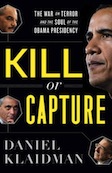Kill or Capture
Reporting on President Obama’s War on Terror.
Kill or Capture: The War on Terror and the Soul of the Obama Presidency. By Daniel Klaidman. Houghton Mifflin Harcourt, 2012. 304 pp.
Newsweek reporter Daniel Klaidman provides the first definitive account of the Obama administration’s wide-ranging counterterrorism policies—from the fate of Guantánamo Bay and indefinite detention to terrorism trials and the legality of targeted killings. Klaidman’s account reveals both the tense deliberations within Obama’s inner circle and the fear-mongering that politicized his counterterrorism policies. What makes Kill or Capture: The War on Terror and the Soul of the Obama Presidency particularly interesting is how it sheds light on the paradox of post-9/11 America: how a country that views itself as a paragon of human rights and international law came to ignore the very values and constitutional protections it continues to champion.
Klaidman’s narrative follows the Obama presidency from the 2008 campaign to the 2012 presidential election, exposing the real story behind why an administration that so appealed to lofty ideals repeatedly abandoned its pledge to harmonize America’s values with national security. For instance, candidate Obama promised to reclaim America’s moral standing by closing Guantánamo Bay, ending indefinite detention, and bringing terrorists to justice in civilian courts. But President Obama, despite signing a series of executive orders that banned coercive interrogation methods and terminated America’s secret overseas prisons (“black sites”), faced a number of challenges shutting down Guantánamo.
Would terror suspects be brought to the mainland and prosecuted in civilian courts? Did enhanced interrogation methods taint the evidence needed to win convictions? What about detainees who had trained in Al-Qaeda camps, but had not necessarily committed any crimes for which they could be prosecuted? Eventually, Obama claimed the authority to hold terrorism suspects in prolonged detention indefinitely without trial, in a symbolic rather than a substantive reversal from the stance of his predecessor that alienated some in his liberal base.
Divisions, both among Obama’s advisers and within partisan Washington, also derailed the president’s counterterrorism agenda. Klaidman writes that in the view of White House Chief of Staff Rahm Emanuel, “Guantánamo was just a pain-in-the-ass distraction.” He and other like-minded advisors pushed for the administration’s laser-like focus on health care and the economy. Moreover, although President George W. Bush had transferred more than five hundred detainees out of Guantánamo—in an effort to shut down the prison in his second term—former Vice President Dick Cheney equated closing Guantánamo with freeing dangerous terrorists. Congress swiftly passed appropriation bills restricting the transfer of detainees. As Klaidman writes, “an institution increasingly defined by demagoguery was not the best place to develop sensible counterterrorism policies.”
Obama encountered another roadblock when his attorney general, Eric Holder, attempted to bring 9/11 mastermind Khaled Sheikh Mohammed and four co-conspirators to justice in a federal court in downtown Manhattan. Obama’s Republican opponents argued that terrorists were not entitled to the protections available in federal court, even though America’s closest allies had tried their terrorist defendants in the cities where Al-Qaeda attacks had occurred—Madrid, London, and Mumbai—and President Bush had routinely prosecuted terrorists in traditional criminal courts, including Zacarias Moussaoui and shoe bomber Richard Reid.
Time and again, a president who had rejected his predecessor’s “feel-it-in-the-gut, shoot-from-the-hip” national security response, sacrificed his own core principles on the altar of political expediency. One area in particular was Obama’s tightened grip over the secretive program of targeted killings using drones, and their expanded deployment beyond the battlefields of Iraq and Afghanistan into Somalia and Yemen.
Questions remain over so-called “signature strikes” or “crowd killing”: targeting groups of men who bore certain characteristics associated with terrorist activity, but whose identities were not necessarily known. It is uncertain whether officials knew whether those they targeted posed a specific and genuine threat to American interests. After all, if certain targets were not focused on attacking America, then the United States could not use international standards for self-defense as a justification for killing them. This makes Klaidman’s characterization of Obama as a “civil libertarian”—a term he neither defines nor fully explains—a bit curious.
Obama greased perhaps his slipperiest slope with the targeted killing of an American citizen neither formally charged with a crime nor convicted at trial: Anwar Al-Awlaki. An online propagandist and chief of external operations for Al-Qaeda in the Arabian Peninsula, Al-Awlaki influenced the Fort Hood shooter and recruited the 2009 Christmas Day bomber. However odious Al-Awlaki may have been, his killing raises complicated legal and moral questions about the danger of unfettered presidential power. In this respect, Kill or Capture successfully frames official day-to-day decision-making within the broader war on terror. The reader is naturally drawn to realize the book’s underlying point: America’s lack of a long-term detention policy may be perversely incentivizing kills over captures.
Malou Innocent is a foreign policy analyst at the Cato Institute. She has written for Survival, Congressional Quarterly, Harvard International Review, Foreign Policy, Wall Street Journal Asia, Christian Science Monitor, Armed Forces Journal, Guardian, Washington Times, and other publications.



